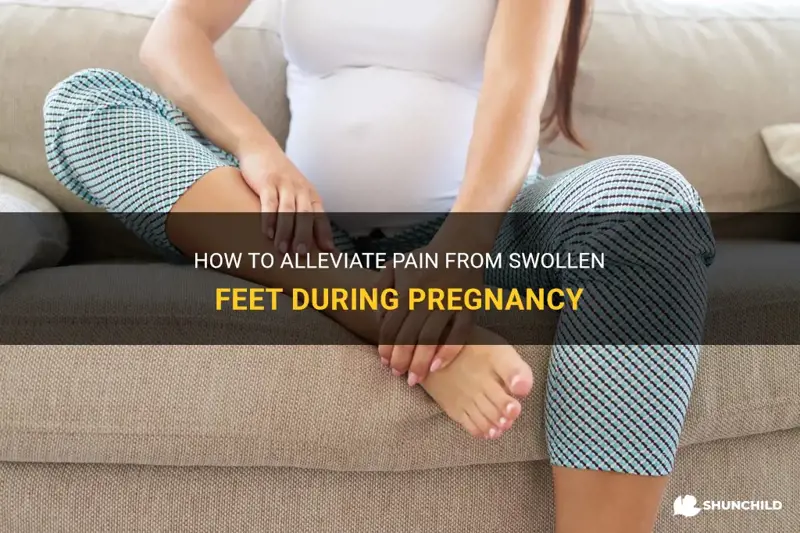
Pregnancy is an incredibly exciting and transformative time in a woman's life, but it can also come with its fair share of discomforts. One common inconvenience that many expectant mothers experience is swollen feet. This swelling, also known as edema, occurs due to the increased blood volume and fluid retention that naturally happens during pregnancy. While it may be normal, swollen feet can be quite painful and hinder daily activities. Fortunately, there are several effective methods to reduce this discomfort and make the foot pain more manageable. By implementing simple lifestyle changes and incorporating specific exercises and relaxation techniques into your routine, you can alleviate the pain and enjoy a more comfortable pregnancy.
| Characteristics | Values |
|---|---|
| Causes of swollen feet | - Water retention |
| - Increased blood volume | |
| - Hormonal changes | |
| - Pressure on blood vessels | |
| - Weight gain | |
| - Poor circulation | |
| Ways to reduce swollen feet | - Elevating legs |
| - Avoiding standing or sitting for long periods | |
| - Wearing supportive footwear | |
| - Staying hydrated | |
| - Avoiding salty foods | |
| - Gentle exercise | |
| - Compressing feet with socks or stockings | |
| - Massage and foot stretches | |
| - Cooling down feet with ice packs or cold water | |
| - Seeking professional help if necessary |
What You'll Learn
- What are some effective methods for reducing swollen feet pain during pregnancy?
- Are there any specific exercises or stretches that can help alleviate swollen feet pain?
- Are there any home remedies or natural remedies that can provide relief from swollen feet pain during pregnancy?
- Are there any specific shoes or footwear that are recommended for reducing swollen feet pain during pregnancy?
- Are there any potential underlying medical conditions that could be causing the swollen feet pain during pregnancy, and should I seek medical attention if the pain persists or worsens?

What are some effective methods for reducing swollen feet pain during pregnancy?
Pregnancy comes with a range of physical changes, and one common discomfort that many pregnant women experience is swollen feet. This condition, known as edema, is caused by an increase in blood volume and pressure on the blood vessels due to the growing uterus. Swollen feet can be both uncomfortable and painful, but there are several effective methods for reducing the pain associated with this condition. In this article, we will explore some of these methods and how they can provide relief during pregnancy.
One of the most important steps in reducing swollen feet pain during pregnancy is maintaining proper hydration. Drinking an adequate amount of water throughout the day can help prevent water retention and keep the body's fluid levels in balance. It is recommended for pregnant women to drink at least eight to ten glasses of water daily. Additionally, consuming foods with high water content, such as fruits and vegetables, can also contribute to proper hydration.
Another effective method for reducing swollen feet pain is practicing regular exercise. Gentle exercises, such as walking, swimming, and prenatal yoga, can help improve blood circulation and reduce fluid buildup in the lower extremities. Engaging in regular physical activity not only aids in reducing swelling and pain but also promotes overall well-being during pregnancy. It is important to consult with a healthcare professional before starting any exercise regimen to ensure it is safe for both the mother and the baby.
Wearing comfortable and supportive footwear is crucial in alleviating swollen feet pain. Opting for shoes with a wide toe box and a low heel can help prevent added pressure on the feet and improve blood circulation. It is best to avoid tight-fitting shoes, as they can constrict blood flow and exacerbate swelling. Additionally, wearing compression socks or stockings can provide extra support and help reduce fluid retention in the legs and feet.
Elevating the feet is another effective method for reducing pain and discomfort caused by swollen feet. Raising the feet above heart level while sitting or lying down can help promote blood flow and reduce swelling. It is recommended to prop the feet up on a pillow or cushion for at least thirty minutes, several times a day. This simple yet effective technique can provide significant relief and should be incorporated into the daily routine of pregnant women.
In some cases, a cold compress can be used to alleviate swollen feet pain. Applying a cold pack or an ice pack wrapped in a towel to the affected area can help constrict blood vessels and reduce swelling. It is important to avoid applying ice directly to the skin to prevent injury. Heating pads or warm water soaks should be avoided as they can worsen swelling by dilating blood vessels.
Lastly, maintaining a healthy diet can contribute to reducing swollen feet pain during pregnancy. Avoiding excessive salt intake can help prevent water retention and minimize swelling. Consuming foods rich in potassium, such as bananas, can also help reduce fluid buildup in the body. It is recommended to consult with a healthcare provider or a registered dietitian for personalized dietary advice during pregnancy.
In conclusion, swollen feet pain during pregnancy can be effectively reduced by following certain methods. Proper hydration, regular exercise, wearing comfortable footwear, elevating the feet, using cold compresses, and maintaining a healthy diet are all effective strategies for relieving pain and discomfort from swollen feet. It is important for pregnant women to prioritize self-care and consult with healthcare professionals for personalized advice on managing this condition. By implementing these methods, pregnant women can experience relief and enjoy a more comfortable pregnancy journey.
Comparing the Pain Levels: Pregnancy with Kidney Stones vs. Without
You may want to see also

Are there any specific exercises or stretches that can help alleviate swollen feet pain?
Swollen feet can be caused by a variety of factors, including pregnancy, standing or sitting for long periods, and certain medical conditions such as diabetes or kidney disease. Regardless of the cause, swollen feet can be extremely uncomfortable and can even interfere with daily activities. Fortunately, there are several exercises and stretches that can help alleviate the pain and discomfort associated with swollen feet.
One of the most effective exercises for reducing swelling in the feet is ankle pumps. To perform this exercise, simply sit in a chair with your feet flat on the floor. Slowly flex your feet, pulling your toes towards your body. Then, point your toes away from your body as far as you can. Repeat this motion for a few minutes, several times a day. Ankle pumps help to improve circulation and reduce fluid buildup in the feet.
Another helpful exercise for swollen feet is calf stretches. Stand facing a wall and place your hands on the wall for support. Step one foot back, keeping both heels on the ground. Lean forward, stretching the calf of the back leg. Hold this stretch for 30 seconds, then slowly release. Repeat on the other side. Calf stretches help to improve blood flow in the lower legs and alleviate swelling.
In addition to specific exercises, there are also some general activities that can help reduce the pain and discomfort associated with swollen feet. Elevating the feet above heart level can help promote drainage of excess fluid and reduce swelling. Try lying on your back with your feet propped up on pillows or sitting in a reclining chair with your feet elevated on a footrest.
Wearing compression socks or stockings can also help alleviate swelling in the feet. These specially designed socks apply pressure to the lower legs, promoting blood flow and reducing fluid buildup. Compression socks are available in varying levels of compression and can be purchased at most pharmacies or medical supply stores.
It's important to note that if you are experiencing persistent or severe swelling in your feet, it is best to consult with a healthcare professional. They can help determine the underlying cause of your swelling and recommend appropriate treatment options. In some cases, medication or other interventions may be necessary to alleviate the swelling.
In conclusion, there are several exercises and stretches that can help alleviate the pain and discomfort associated with swollen feet. Ankle pumps and calf stretches are particularly effective at improving circulation and reducing fluid buildup. Additionally, elevating the feet and wearing compression socks can provide relief. However, it is always best to consult with a healthcare professional for an accurate diagnosis and personalized treatment plan.
The Potential Risks: Is Excessive Sun Exposure Harmful During Pregnancy?
You may want to see also

Are there any home remedies or natural remedies that can provide relief from swollen feet pain during pregnancy?
Swollen feet are a common occurrence during pregnancy due to increased fluid retention and pressure on the blood vessels. This can lead to discomfort and pain, making it essential for pregnant women to find relief. While there is no surefire cure for swollen feet, several home remedies and natural remedies can help alleviate the pain and discomfort associated with this condition.
One popular home remedy for swollen feet during pregnancy is soaking them in cool water. This can help reduce swelling and provide temporary relief from pain. Adding a few drops of essential oils, such as lavender or peppermint, to the water can enhance the soothing effect. Another option is to freeze a bottle of water and roll it under the feet for a refreshing massage.
Elevating the feet is another effective home remedy for swollen feet during pregnancy. By propping the feet up on pillows or cushions, pregnant women can help reduce the fluid accumulation in the lower limbs and promote better circulation. This simple remedy can be done multiple times a day, especially after long periods of standing or walking.
Compression socks or stockings can also provide relief from swollen feet during pregnancy. These garments apply gentle pressure to the legs, helping to prevent fluid buildup and promote better blood flow. They can be worn throughout the day and can provide a significant amount of comfort and pain relief.
Staying hydrated is crucial for pregnant women, but it can also help reduce swelling in the feet. Drinking plenty of water throughout the day can help flush out excess fluids from the body and prevent fluid retention. Cutting back on salt consumption can also help reduce swelling, as excess salt can lead to water retention.
Regular exercise, such as walking or swimming, can also help alleviate swollen feet during pregnancy. Physical activity promotes better circulation and helps prevent fluid buildup in the lower limbs. However, pregnant women should consult with their healthcare provider before starting any exercise regimen to ensure it is safe for them and their baby.
In addition to these home remedies, there are a few natural remedies that can provide relief from swollen feet during pregnancy. A warm bath with Epsom salt can help reduce swelling and provide relaxation. Epsom salt contains magnesium sulfate, which can be absorbed through the skin and help promote better circulation.
Massaging the feet and legs can also help reduce swelling and alleviate pain. Using gentle, circular motions and a moisturizing lotion or oil can help improve blood flow and reduce fluid retention. Pregnant women can do this themselves or ask their partner for a foot and leg massage to experience even more relaxation.
In conclusion, while there is no guaranteed cure for swollen feet during pregnancy, there are several home remedies and natural remedies that can provide relief from pain and discomfort. Soaking the feet in cool water, elevating the feet, wearing compression socks, staying hydrated, engaging in regular exercise, and using natural remedies such as Epsom salt baths and foot massages can all contribute to reducing swelling and promoting better circulation. It is always important for pregnant women to consult with their healthcare provider before trying any new remedies or treatments to ensure the safety and well-being of both themselves and their baby.
Understanding the Discomforts of Pregnancy: Does it Pain During Pregnancy?
You may want to see also

Are there any specific shoes or footwear that are recommended for reducing swollen feet pain during pregnancy?
Swollen feet and ankle pain are common discomforts experienced by many pregnant women. This swelling, also known as edema, occurs due to an increase in blood volume and pressure on the veins. While there are various remedies and lifestyle changes that can help alleviate this discomfort, choosing the right footwear is essential for reducing swollen feet pain during pregnancy.
During pregnancy, it is recommended to wear shoes that provide proper support, cushioning, and comfort. Here are some specific types of footwear that can help reduce swollen feet pain:
- Comfortable and Supportive Shoes: Look for shoes with a wide toe box, as it allows for better circulation and accommodates swollen feet. Opt for shoes made of breathable materials, such as mesh or canvas, as they allow more airflow, preventing excessive sweating and further swelling. Additionally, shoes with arch support and cushioned soles help distribute body weight evenly and reduce pressure on the feet.
- Orthotic Inserts: Inserts or insoles with arch support can provide additional relief for swollen and painful feet. These inserts are designed to support the arches of the feet and help maintain proper alignment, reducing strain on the feet and ankles. Custom orthotics can also be beneficial as they are specifically tailored to an individual's foot shape and needs.
- Compression Socks: Compression socks or stockings are specially designed to promote blood circulation and reduce swelling. These socks apply graduated pressure, with the highest pressure at the ankles and gradually decreasing towards the knees. They help prevent fluid buildup in the feet and ankles, providing relief from discomfort and pain.
- Adjustable and Wide-Fitting Sandals: As swollen feet may vary in size throughout the day, choosing sandals with adjustable straps or Velcro closures can accommodate the changing size of the feet. Wide-fitting sandals made of soft and stretchable materials, such as leather or fabric, can also provide more room for swollen feet and reduce friction.
- Low-Heeled Shoes: High heels and shoes with narrow toe boxes can worsen swollen feet pain during pregnancy. Opt for low-heeled shoes with a wide base for better stability and to prevent any further strain on the feet. It is best to avoid shoes with pointed toes, as they can compress the toes and lead to discomfort.
- Avoid Tight and Restrictive Shoes: Shoes that are too tight or have restrictive straps can impair circulation and exacerbate swelling. It is important to choose shoes that allow for natural foot movement and do not constrict the feet.
It is essential to keep in mind that every woman's feet may swell to different degrees during pregnancy. Therefore, it is crucial to find footwear that fits well and provides the necessary support and comfort. Additionally, elevating the legs, staying hydrated, and regularly exercising can also help reduce swollen feet pain. If the swelling persists or is severe, it is always advisable to consult with a healthcare professional for further evaluation and guidance.
Why Does Pregnancy Cause Excessive Bloating? Understanding the Causes and Solutions
You may want to see also

Are there any potential underlying medical conditions that could be causing the swollen feet pain during pregnancy, and should I seek medical attention if the pain persists or worsens?
Swollen feet during pregnancy is a common occurrence due to the increased fluid retention and pressure on the blood vessels caused by the growing uterus. However, in some cases, there may be underlying medical conditions that could be causing the swollen feet pain. It is important to be aware of these conditions and know when to seek medical attention if the pain persists or worsens.
One potential underlying medical condition that could cause swollen feet during pregnancy is preeclampsia. Preeclampsia is a serious condition characterized by high blood pressure and damage to organs such as the liver and kidneys. Swelling of the feet, hands, and face is one of the symptoms of preeclampsia. Other symptoms may include severe headaches, vision changes, and upper abdominal pain. If you are experiencing any of these symptoms, it is crucial to seek immediate medical attention, as preeclampsia can be life-threatening if left untreated.
Another condition that could be causing swollen feet during pregnancy is deep vein thrombosis (DVT). DVT occurs when a blood clot forms in a deep vein, often in the legs. Symptoms of DVT include swelling, pain, and warmth in the affected area. If you are experiencing these symptoms along with swollen feet, it is important to consult a healthcare professional, as DVT can be a serious condition that requires treatment to prevent complications such as pulmonary embolism.
Additionally, certain medical conditions such as gestational diabetes and gestational hypertension can also contribute to swollen feet during pregnancy. Gestational diabetes is a condition characterized by high blood sugar levels during pregnancy, while gestational hypertension is high blood pressure that develops during pregnancy. Both of these conditions can lead to fluid retention and swelling in the feet and ankles. If you have been diagnosed with either of these conditions, it is important to work closely with your healthcare provider to manage your symptoms and prevent complications.
If you are experiencing swollen feet during pregnancy, it is essential to take steps to manage the swelling and alleviate the pain. Elevating the feet whenever possible, wearing comfortable shoes, avoiding standing for long periods, and practicing exercises recommended by your healthcare provider can help reduce swelling. Additionally, drinking plenty of water and avoiding excessive salt intake may also help prevent fluid retention.
However, if the pain and swelling persist or worsen despite these measures, it is important to seek medical attention. Your healthcare provider can evaluate your symptoms, rule out any underlying medical conditions, and provide appropriate treatment if necessary. They may also recommend further tests or consultations with specialists, such as a maternal-fetal medicine specialist or a vascular specialist, depending on the severity of your symptoms.
In conclusion, while swollen feet during pregnancy are usually a normal part of the pregnancy process, there may be underlying medical conditions that could be causing the pain and swelling. It is important to be aware of these potential conditions and know when to seek medical attention if the pain persists or worsens. Consulting with a healthcare professional can help ensure that any underlying medical conditions are properly diagnosed and treated, promoting the health and well-being of both the mother and baby.
Understanding Breast Pain in the First Month of Pregnancy
You may want to see also
Frequently asked questions
During pregnancy, the body produces extra fluids and blood to support the growing baby. This increase in fluid can cause swelling, especially in the feet and ankles, due to the body's decreased ability to efficiently circulate fluids. The pressure from the growing uterus can also contribute to fluid retention in the lower extremities.
There are several ways to reduce swelling and pain in the feet during pregnancy. Elevating the feet whenever possible can help improve circulation and reduce fluid build-up. Wearing comfortable shoes that provide adequate support, avoiding tight socks or stockings, and avoiding excessive standing or sitting for long periods can also help reduce swelling. Staying hydrated and consuming a low-sodium diet can also help minimize fluid retention.
Yes, it is generally safe to use compression socks or stockings during pregnancy to help reduce swelling and pain in the feet. However, it is important to consult with a healthcare provider before using any compression garments to ensure they are the right fit and level of compression for your specific needs. Wearing them properly and avoiding overcompression is also crucial to ensure optimal circulation.
Yes, gentle massage can be beneficial in reducing swollen feet pain during pregnancy. Massaging the feet and ankles in an upward motion towards the heart can help improve circulation and reduce fluid build-up. However, it is important to avoid deep tissue massage or pressure points that could potentially trigger contractions. It is always best to consult with a qualified prenatal massage therapist or healthcare provider before beginning any massage therapy during pregnancy.
While some swelling in the feet and ankles is normal during pregnancy, sudden or severe swelling accompanied by other symptoms such as headache, vision changes, abdominal pain, or decreased urine output could be a sign of a more serious condition called preeclampsia. If you experience any of these symptoms, it is important to contact your healthcare provider right away for proper evaluation and guidance.







